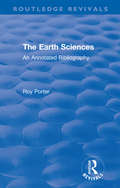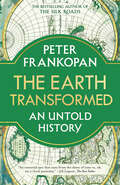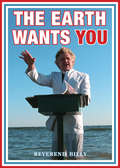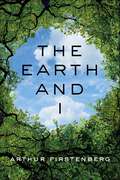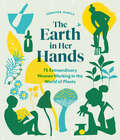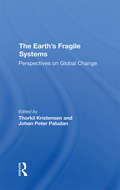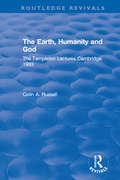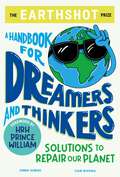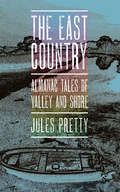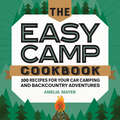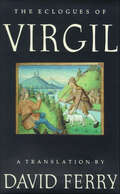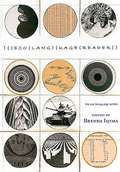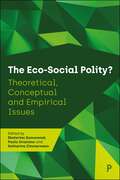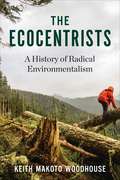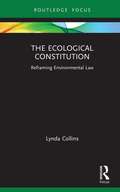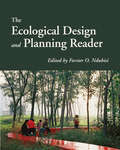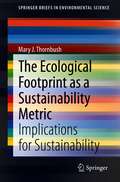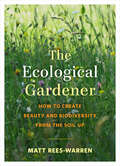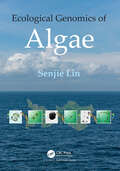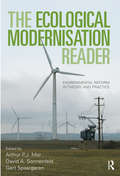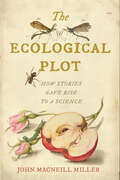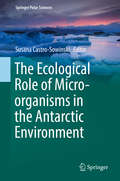- Table View
- List View
The Earth Sciences: An Annotated Bibliography (Routledge Revivals)
by Roy PorterOriginally published in 1983, The Earth Sciences: An Annotated Bibliography is a compact and thematically organized guide that provides comprehensive access to themes and areas of study in the earth sciences. The bibliography is not exhaustive but provides a detailed and critical index to the most important literature in the field. The book’s core focus is geology and examines the subject broadly, covering everything from glaciology, geomorphology, natural history and palaeontology, to oceanography, mapping, stratigraphy and evolution. The book provides detailed essays for each bibliographical chapter on the state of each field of research and the literature compiled for each bibliography will go as far back as around 1700 and contains a wide range of sources from across the world. This book will be of interest to academics and students of natural history, geology, and environmental sciences alike.
The Earth Transformed: An Untold History
by Peter FrankopanA NEW YORKER BEST BOOK OF THE YEAR • A revolutionary new history that reveals how climate change has dramatically shaped the development—and demise—of civilizations across time*The ebook edition now includes endnotes. Anyone who purchased the book previously can re-download this updated edition and access the notes.* Global warming is one of the greatest dangers mankind faces today. Even as temperatures increase, sea levels rise, and natural disasters escalate, our current environmental crisis feels difficult to predict and understand. But climate change and its effects on us are not new. In a bold narrative that spans centuries and continents, Peter Frankopan argues that nature has always played a fundamental role in the writing of history. From the fall of the Moche civilization in South America that came about because of the cyclical pressures of El Niño to volcanic eruptions in Iceland that affected Egypt and helped bring the Ottoman empire to its knees, climate change and its influences have always been with us. Frankopan explains how the Vikings emerged thanks to catastrophic crop failure, why the roots of regime change in eleventh-century Baghdad lay in the collapse of cotton prices resulting from unusual climate patterns, and why the western expansion of the frontiers in North America was directly affected by solar flare activity in the eighteenth century. Again and again, Frankopan shows that when past empires have failed to act sustainably, they have been met with catastrophe. Blending brilliant historical writing and cutting-edge scientific research, The Earth Transformed will radically reframe the way we look at the world and our future.
The Earth Wants YOU
by Reverend Billy Talen"You must check out the newest from my favorite transcendent and down to earth preacher."--Laurie Anderson, artist, musicianThe Earth Wants YOU is a motivational handbook, filled with inspired visions of a wild, creative, Earth-led cultural revolution. Reverend Billy and the Church of Stop Shopping offer up a heady mix of humor, insightful critique, passionate commitment, emotional catharsis, and example after example of vibrant direct action. Stop shopping and feel the love as you sign up for the struggle of our lives! Earthalujah!Praise for The Earth Wants YOU:"Singing instructions for joining the Earthalujah choir!"--Jodie Evans, CODEPINK"My Earthmojis are smiling for Reverend Billy! And that's all the dirt you're gonna get from me. O;"--Justin Vivian Bond, trans-genre artist, Radical Faerie"Mama Earth will shake us ALL off unless we shake shit UP and shut it DOWN!"--Bertha Lewis, The Black Institute"This is what makes social movements succeed--it's the big love-slog we have to go through to achieve change."--Andy Bichlbaum, The Yes Men"Join Rev and his merry band of activists as they imagine ways of arousing concern for the environment and racial justice."--Coco Fusco, creator of Eu Sou Um Consumidor"When the singing activists hit the high notes in a bank lobby or a DARPA lab or the back aisle of a Walmart, they wipe away the veils hiding the madness of our corporate-controlled, consumer-crazed society."--Annie Leonard, director of Greenpeace USA"Ssssh, listen . . . let the Church of Stop Shopping exorcise your fear, doubt and burnout, and join the Earthalujah Revolution!"-Jess Worth, BP or not BP?"This call to action is at once sobering and encouraging. We have fucked up really badly, but the ability to see it-is the first and hardest step toward fixing it."--Douglas Rushkoff, author of Throwing Rocks at the Google Bus"Reverend Billy's ALL IN! bodies and voices . . . not just clicks and posts, for this small village we call Earth. Preach On!"--Obang Metho, Solidarity Movement for a New Ethiopia"The Stop Shoppers packs a whoop."--Roberto Sifuentes, La Pocha Nostra"In between satire and silence, there is a space of penetrating reckoning for all vibrations that flow counter to the balance of Nature. And from this dynamic and tricky space, the Honorable Reverend and his Holified Choir will shout, sing and sermonize a soul-bound love message of Truthalujah!"--John Sims, The AfroDixie Remixes"The Church of Stop Shopping is in the vanguard of a new movement that challenges this consumer society that is killing our planet."--Mike Roselle, Climate Ground Zero and Coal River Mountain Watch"Billy, Savi and the choir have love and optimistic humor, and they don't give up on people."--David LaChapelle, comedian"He seems to be writing while his actions are going on, like he can write while he's hand-cuffed."--Benny Zable, The Nimbin Environment Centre, NSW Australia"The Earth Wants You takes readers deep inside the heart, mind and balls of the activist-artist. Reverend Billy rocks hard!"--Annie Sprinkle, artist, ecosexual sexecologist"He was a comic act. Now he's evolved into a man compulsively challenging the true extent of the right to protest."--Anohni, creator of the song "4 Degrees"Reverend Billy and his choir of singing-activists are on the front lines of creative direct action, and here they offer up a distillation of the passion, the inspiration, and the hopes for love and survival that fuel their work. In a mix of essays, polemics, surrealist scenarios and news flashes from the frontlines, Reverend Billy answers the question, "What are we to do?" with a resounding chorus of "Take Action NOW!"
The Earth and I
by Arthur FirstenbergAlmost all environmental books treat the environmental crisis as though humans are in charge of nature, rather than part of it. The Earth and I is the first book to put all preconceived notions aside and to ask, naïvely: Who are we really? What is our relationship to the earth? How is it possible that we, out of all the millions of species, have come to destroy our common home? The answers are surprising and have far-reaching implications for those searching for solutions. Part One tells what is happening to the earth&’s systems and how they are being destroyed. It rewrites the two-million-year history of humanity&’s tenure on the earth as if we are part of nature and not separate from it, and describes both the earth and the universe as living systems. It paints a global, coherent picture of the devastation to Earth&’s air, water, forests, and creatures that is not found elsewhere. It reviews assaults on these systems that are not treated adequately, if at all, elsewhere: chemicals; radiation; plastics; detergents; biocides; noise; cars; and guns. Part Two, &“Digging below the Surface,&” asks why, and enters territory not previously explored by environmentalists. It describes the various ways to make a living on the earth—hunting and gathering, shifting agriculture, nomadic herding, settled agriculture, and industrial technology—as choices, not eras—choices coexisting with one another until today. It rewrites economics. It explores the relationship of warfare, slavery, religion, and human sexuality to the environmental crisis. And it is forced to conclude that these aspects of human culture are not only shaped, but created by the technologies we use; that the use of non-human sources of energy interferes with human psychological development; and that the unfulfilled urges within us explode in the violent technologies that are destroying our planet. The solutions, if it is not too late, therefore lie in wise choice, rather than wise use, of our technologies.
The Earth in Her Hands: 75 Extraordinary Women Working in the World of Plants
by Jennifer Jewell&“An informative and celebratory resource.&” —Booklist In this beautiful and empowering book, Jennifer Jewell—host of public radio&’s award-winning program and podcast Cultivating Place—introduces 75 inspiring women. Working in wide-reaching fields that include botany, floral design, landscape architecture, farming, herbalism, and food justice, these influencers are creating change from the ground up. Profiled women include flower farmer Erin Benzakein; codirector of Soul Fire Farm Leah Penniman; plantswoman Flora Grubb; edible and cultural landscape designer Leslie Bennett; Caribbean-American writer and gardener Jamaica Kincaid; soil scientist Elaine Ingham; landscape designer Ariella Chezar; floral designer Amy Merrick, and many more. Rich with personal stories and insights, Jewell&’s portraits reveal a devotion that transcends age, locale, and background, reminding us of the profound role of green growing things in our world—and our lives.
The Earth's Fragile Systems: Perspectives On Global Change
by Thorkil Kristensen Johan Peter PaludanThe Earth's Fragile Systems is concerned with some of the most pressing and worrying of the problems afflicting our globe, problems that have been discussed in various forums and are well known not to be simple intellectually, practically or politically.
The Earth, Humanity and God: The Templeton Lectures Cambridge, 1993 (Routledge Revivals)
by Colin A. RussellOriginally published in 1994, The Earth, Humanity and God discusses the relationship between science and religion. The book discusses the condition of the earth (as it was at the time of publication) and the future prospects of the planet, arguing that neither the conventional "mechanistic" view nor "New Age" philosophy helps alone in evaluating our relationship with the Earth. The book examines methods of combatting the threats to the Earth exploring both a scientific and non-scientific stance, investigating the uncontrolled expansion of technology as well as empirical pre-scientific mysticism. The book also explores the resurgence in ancient ideas of "Mother Earth" as a dangerous piece of romantic irrationality and suggests, that these views pose a danger to religious/scientific examinations. The book suggests instead a hard-headed attempt to relate Biblical and scientific data, and that this in turn can yield a valuable new understanding of the problems facing the world.
The Earthshot Prize: Solutions to Repair our Planet
by Jonnie Hughes Colin ButfieldAn empowering and practical handbook for young changemakers who want to save the planet! Published in collaboration with the prestigious Earthshot Prize, featuring an introduction from HRH Prince William and contributions from environmental activists including Sir David Attenborough, Christiana Figueres and Shailene Woodley.'Our planet is the only home we have, and we must think big and dream bigger if we are to protect it.'- HRH Prince WilliamThe mission is simple: to repair our planet.Our home is in trouble. The good news is we can fix it - but we need YOUR help. So let's put our heads together and dream up ways to BUILD, CREATE and SHOUT about solutions to repair our planet. In the Earthshot Handbook for Future Dreamers and Thinkers, young readers will travel round the world, celebrating the diverse and rich habitats, amazing animals and wonderful landscapes that make up our planet. They'll learn about the problems and challenges facing those habitats. They will meet Earthshot innovators, entrepreneurs and game changers from the past and present from Wangari Maathai to David Attenborough. And importantly, they'll discover how they can become the changemakers of the future, helping to develop solutions to the world's biggest problems. Because even the smallest idea or Earthshot, has the power to change everything. Full of simple practical things young people can do or make to help save the planet, even from home, as well as big ideas and contributions from people around the globe, this is the ultimate handbook for future innovators and activists who want to make a difference.Contributors to this book:HRH Prince William Naturalist Sir David Attenborough Former UN Climate Chief Christiana FigueresActor Shailene WoodleyAstronaut Naoko YamazkiEnvironmental Activist Hindou Oumarou Ibrahim
The East Country: Almanac Tales of Valley and Shore
by Jules PrettyThe East Country is a work of creative nonfiction in which the acclaimed nature writer Jules Pretty integrates memoir, natural history, cultural critique, and spiritual reflection into a single compelling narrative. Pretty frames his book around Aldo Leopold and his classic A Sand County Almanac, bringing Leopold’s ethic—that some could live without nature but most should not—into the twenty-first century. In The East Country, Pretty follows the seasons through seventy-four tales set in a variety of landscapes from valley to salty shore. Pretty convinces us that we should all develop long attachments to the local, observing that the land can change us for the better.
The East India Company and the Natural World
by Vinita DamodaranThis book is the first to explore the deep and lasting impacts of the largest colonial trading company, the British East India Company on the natural environment. The contributors - drawn from a wide range of academic disciplines - illuminate the relationship between colonial capital and the changing environment between 1600 and 1857.
The Easy Camp Cookbook: 100 Recipes For Your Car Camping and Backcountry Adventures
by Amelia MayerAfter a long day on the trail or while sitting around a roaring fire, food just tastes better than it does at home. Sized perfectly for limited packing space, this all-inclusive camping cookbook will expand your wilderness culinary chops. The Easy Camp Cookbook is a compilation of family favorites that are (mostly) healthy, will fuel your adventures, and are simple to make—no more settling for plain ol' hot dogs and tasteless freeze-dried foods! Organized into two sections: car camping and backcountry camping, this camping cookbook features delicious, easy-to-make recipes. Many recipes can be prepped at home so you can spend more time relaxing and enjoying camping—it even includes vegetarian options! Take the guesswork out of keeping everyone fed with this insightful camping cookbook. Inside this camping cookbook, you'll find: Prep ahead—Many of the recipes utilize at-home prep to make meals that much easier (and cleaner!) at the campsite. Be prepared—Get camping advice, including an at-home prepping guide, camping checklist, safety tips, and more. Light read—The packable size of this handy guide makes it ideal for your next camping trip. This comprehensive camping cookbook will have you eating like a king on the trail!
The Easy Guide to Painting Water in Watercolour
by Stephen CoatesThe ultimate no-nonsense guide to painting realistic, captivating water, from still lakes and crashing waves to water droplets.
The Eclogues of Virgil
by Virgil“Fresh-minted and sparkling . . . Ferry’s translation wonderfully preserves the exquisite harmonies of the mode while giving it a vigorous edge of reality.” —Robert Taylor, The Boston GlobeVirgil’s great lyrics, rendered by the acclaimed translator of Gilgamesh . . . The Eclogues of Virgil gave definitive form to the pastoral mode, and these magically beautiful poems, which were influential in so much subsequent literature, perhaps best exemplify what pastoral can do. “Song replying to song replying to song,’ touchingly comic, poignantly sad, sublimely joyful, the various music that these shepherds make echoes in scenes of repose and harmony, and of hardship and trouble in work and love.Available in ebook for the first time, this English-only edition of The Eclogues of Virgil includes concise, informative notes and an introduction that describes the fundamental role of this deeply original book in the pastoral tradition.“Direct, unmannered and fresh: a modern version of classical simplicity.” —Merle Rubin, Los Angeles Times“Mr. Ferry is a gifted poet and much-admired translator . . . Those to whom the original is a sealed book will enjoy much of its charm through the medium of the author’s accomplished translation, while those who, like Shakespeare, have ‘small Latin’ can experience the additional pleasure of savoring, with Mr. Ferry’s help, the musical perfection of Virgil’s lines.” —Bernard Knox, The Washington Times“Ferry has achieved a high degree of fidelity to what Virgil wrote . . . Simple, luminous clarity.” —Richard Jenkyns, The New Republic
The Eco Language Reader
by Brenda IijimaHow can poetry engage with a global ecosystem under duress? How do poetic languages, forms, structures, syntaxes, and grammars contend or comply with the forces of environmental disaster? Can innovating languages forward the cause of living sustainably in a world of radical interconnectedness? In what ways do vectors of geography, race, gender, class, and culture intersect with the development of individual or collective ecopoetic projects? <p><p> Contributors include: Karen Leona Anderson, Jack Collom, Tina Darragh, Marcella Durand, Laura Elrick, Brenda Iijima, Peter Larkin, Jill Magi, Tracie Morris, Catriona Mortimer-Sandilands, Julie Patton, Jed Rasula, Evelyn Reilly, Leslie Scalapino, James Sherry, Jonathan Skinner, and Tyrone Williams. <p> Co-published with Portable Press at Yo-Yo Labs
The Eco-Social Polity?: Theoretical, Conceptual and Empirical Issues
by Ekaterina Domorenok, Paolo Graziano and Katharina ZimmermannThe devastating effects of climate change are undeniable. Fires rage and waters rise in every corner of the globe. In light of these changes to our planet, the issue of social and environmental wellbeing has gained prominent attention from both academia and policy makers. Scholarly research on the interaction between social and employment policy domains has flourished. Academics now reflect on the different aspects of environmental and social protection, ecological and social risks, and the costs of climate change, sustainable welfare and new social movements prompted by green transitions. This book provides a vital contribution to the emerging research agenda. It brings together scholars from interconnected disciplines to discuss the eco-social debate, providing a critical overview on extant scholarship and reflecting on future research pathways on the eco-social nexus from a variety of analytical perspectives.
The Ecocentrists: A History of Radical Environmentalism
by Keith Makoto WoodhouseDisenchanted with the mainstream environmental movement, a new, more radical kind of environmental activist emerged in the 1980s. Radical environmentalists used direct action, from blockades and tree-sits to industrial sabotage, to save a wild nature that they believed to be in a state of crisis. Questioning the premises of liberal humanism, they subscribed to an ecocentric philosophy that attributed as much value to nature as to people. Although critics dismissed them as marginal, radicals posed a vital question that mainstream groups too often ignored: Is environmentalism a matter of common sense or a fundamental critique of the modern world?In The Ecocentrists, Keith Makoto Woodhouse offers a nuanced history of radical environmental thought and action in the late-twentieth-century United States. Focusing especially on the group Earth First!, Woodhouse explores how radical environmentalism responded to both postwar affluence and a growing sense of physical limits. While radicals challenged the material and philosophical basis of industrial civilization, they glossed over the ways economic inequality and social difference defined people’s different relationships to the nonhuman world. Woodhouse discusses how such views increasingly set Earth First! at odds with movements focused on social justice and examines the implications of ecocentrism’s sweeping critique of human society for the future of environmental protection. A groundbreaking intellectual history of environmental politics in the United States, The Ecocentrists is a timely study that considers humanism and individualism in an environmental age and makes a case for skepticism and doubt in environmental thought.
The Ecological Constitution: Reframing Environmental Law (Routledge Focus on Environment and Sustainability)
by Lynda CollinsThe Ecological Constitution integrates the insights of environmental constitutionalism and ecological law in a concise, engaging and accessible manner. This book sets out the necessary components of any constitution that could be considered "ecological" in nature. In particular, it argues that an ecological constitution is one that codifies the following key principles, at a minimum: the principle of sustainability; intergenerational equity and the public trust doctrine; environmental human rights; rights of nature; the precautionary principle and non-regression; and rights and obligations relating to a healthy climate. In the context of the global environmental crisis that characterises the current Anthropocene era, these principles are important tools for changing consciousness and driving pragmatic policy reforms around the world. Re-imagining constitutions along these lines could play a vital role in the collective project of building a sustainable future for humans, animals, ecosystems and the biosphere we all share. This book will be of great interest to students and scholars of environmental law, ecological law, environmental constitutionalism, sustainability and rights of nature.
The Ecological Design and Planning Reader
by Forster O. NdubisiFrom Henry David Thoreau to Rachel Carson, writers have long examined the effects of industrialization and its potential to permanently alter the world around them. Today, as we experience rapid global urbanization, pressures on the natural environment to accommodate our daily needs for food, work, shelter, and recreation are greatly intensified. Concerted efforts to balance human use with ecological concerns are needed now more than ever. A rich body of literature on the effect of human actions on the natural environment provides a window into what we now refer to as ecological design and planning. The study and practice of ecological design and planning provide a promising way to manage change in the landscape so that human actions are more in tune with natural processes. In The Ecological Design and Planning Reader Professor Ndubisi offers refreshing insights into key themes that shape the theory and practice of ecological design and planning. He has assembled, synthesized, and framed selected seminal published scholarly works in the field from the past one hundred and fifty years----ranging from Ebenezer Howard's Garden Cities of To-morrow to Anne Whiston Spirn's, "Ecological Urbanism: A Framework for the Design of Resilient Cities. " The reader ends with a hopeful look forward, which suggests an agenda for future research and analysis in ecological design and planning. This is the first volume to bring together classic and contemporary writings on the history, evolution, theory, methods, and exemplary practice of ecological design and planning. The collection provides students, scholars, researchers, and practitioners with a solid foundation for understanding the relationship between human systems and our natural environment.
The Ecological Footprint as a Sustainability Metric: Implications for Sustainability (SpringerBriefs in Environmental Science)
by Mary J. ThornbushThis book examines the Ecological Footprint and biocapacity accounting within an applied development content for Costa Rica. By doing so, it is possible to track changes as well as perhaps link these to overarching global issues, such as trade, globalization, and food security, among other emergent topics based findings stemming from this methodology. Based on a timeseries since 1961, it is possible to track cross-temporal changes of land-type categories (for crop land, grazing land, forest land, fishing ground, built-up land, and carbon) of the Ecological Footprint and biocapacity conveying whether a country is in ecological deficit and what may be contributing to such a trend
The Ecological Gardener: How to Create Beauty and Biodiversity from the Soil Up
by Matt Rees-WarrenDesign a garden for the future—because what we grow matters. "Matt Rees-Warren explains why every square inch of Earth, including our gardens, has ecological significance... Excellent, timely, essential!" —Douglas W. Tallamy, author of Nature’s Best Hope Transform your garden into a self-sustaining haven for nature and wildlife. Ecological garden designer Matt Rees-Warren shares inspirational design ideas and practical projects to help you create a garden that is both beautiful today and sustainable tomorrow. The Ecological Gardener will give you the tools to create an abundant, healthy garden from the soil up—a garden that welcomes birds and bees and allows native planting and wild flowers to flourish, with minimal carbon impact or need for fresh water. This book can guide both novice and experienced gardeners alike in their journey to a more ecological approach, and is full of practical projects and information, including: Finding the right design for your space Creating a wildflower meadow Building rainwater catchments and other tips for water conservation Making compost from kitchen waste, leaf mold, compost tea and more Creating a space for wildlife such as hedgehogs, bees and other pollinators Finding beauty in your garden during the winter Matt will show you how to re-imagine how you garden, working with nature instead of controlling it, to create a space that promotes both wildlife and beauty.
The Ecological Gardener: How to Create Beauty and Biodiversity from the Soil Up
by Matt Rees-WarrenDesign a garden for the future—because what we grow matters."Matt Rees-Warren explains why every square inch of Earth, including our gardens, has ecological significance... Excellent, timely, essential!" —Douglas W. Tallamy, author of Nature&’s Best HopeTransform your garden into a self-sustaining haven for nature and wildlife. Ecological garden designer Matt Rees-Warren shares inspirational design ideas and practical projects to help you create a garden that is both beautiful today and sustainable tomorrow.The Ecological Gardener will give you the tools to create an abundant, healthy garden from the soil up—a garden that welcomes birds and bees and allows native planting and wild flowers to flourish, with minimal carbon impact or need for fresh water. This book can guide both novice and experienced gardeners alike in their journey to a more ecological approach, and is full of practical projects and information, including: • Finding the right design for your space• Creating a wildflower meadow• Building rainwater catchments and other tips for water conservation• Making compost from kitchen waste, leaf mold, compost tea and more• Creating a space for wildlife such as hedgehogs, bees and other pollinators• Finding beauty in your garden during the winterMatt will show you how to re-imagine how you garden, working with nature instead of controlling it, to create a space that promotes both wildlife and beauty.
The Ecological Genomics of Algae
by Senjie LinDiscover the captivating world of algae through the lens of genomics in Ecological Genomics of Algae. This comprehensive resource explores the evolutionary, ecological, and molecular foundations of algal biology. Spanning 21 chapters, it delves into genome evolution, environmental adaptation, energy acquisition, nutrient uptake, environmental sensing and signal transduction, stress responses, defense, and algae-microbe interactions. From unicellular forms to complex seaweeds, this book illuminates how algae navigate their environments and adapt to climate change. Ideal for researchers and students, it provides cutting-edge insights into the genomic mechanisms driving one of nature's most versatile and essential groups of organisms.
The Ecological Modernisation Reader: Environmental Reform in Theory and Practice
by Arthur P.J. MolStructural environmental reform by firms and industries, governmental and intergovernmental agencies, non-governmental organisations (NGOs), and others is a worldwide phenomenon and the focus of this definitive collection. Includes a comprehensive introduction to and overview of Ecological Modernisation Theory; original, state-of-the-art review essays by distinguished international scholars; a selection of the best published works and debates from a quarter-century of related social science scholarship; an emphasis on environmental issues in Asian and other emerging economies; and an agenda for continued scholarship, policymaking, and practice. Accessible to students, policymakers, professionals, executives, and others interested in deeply understanding contemporary environmental issues and taking effective action for environmental solutions. Rigorous and sophisticated for use in graduate and advanced studies. Appropriate for courses in Sociology, Political Science, Policy Studies, Geography, Environmental Studies, Environmental Planning, Business, Economics, Asian Studies, Development Studies, and other fields.
The Ecological Plot: How Stories Gave Rise to a Science (Under the Sign of Nature)
by John MacNeill MillerUnraveling the surprising history of the concept of ecologyThe Ecological Plot traces the roots of this most mainstream branch of science back to an unexpected source: narrative storytelling. Weaving together the histories of different disciplines, John MacNeill Miller shows how pioneering thinkers drew on a shared set of literary techniques to imagine how different species could work together as a single, interdependent community, redefining the way we conceptualize the natural world. Beginning with a series of revolutionary exchanges between the political economist Thomas Robert Malthus, the writer Harriet Martineau, and the naturalist Charles Darwin, The Ecological Plot identifies the foundations of modern notions of ecology, economics, and realist fiction, maps how they evolved through the works of Victorian writers such as Elizabeth Gaskell, George Eliot, and Thomas Hardy, and shows how they resurfaced in the works of Aldo Leopold and Rachel Carson a century later. Miller&’s book reveals why our most sophisticated efforts to explain humanity&’s relationship to nature have been segregated into different disciplines and makes an argument for the importance of bringing these separate ways of understanding the world back together as a crucial step toward solving the environmental, economic, and ethical problems of the present.
The Ecological Role of Micro-organisms in the Antarctic Environment (Springer Polar Sciences)
by Susana Castro-SowinskiThis book provides up-to-date multidisciplinary information regarding microbial physiological groups in terms of their role in the Antarctic ecology. How do microorganisms shape the Antarctic environment? The book presents a thorough overview of the most important physiological microbial groups or microbial systems that shape the Antarctic environment. Each microbial model is described in terms of their physiology and metabolism, and their role in the Antarctic environmental sustainability. The individual chapters prepare readers for understanding the relevance of the microbial models from both an historical perspective, and considering the latest developments. This book will appeal to researchers and teachers interested in the Antarctic science, but also to students who want to understand the role of microbes in the ecology of extreme environments.
